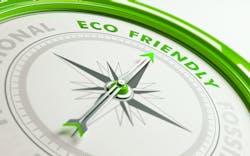The demand for sustainable, efficient facilities has driven a significant change in the commercial building industry. Building owners and facility managers are looking for products that not only are energy efficient, but also are sustainably designed and sourced with minimal impact to the environment and the health of building occupants.
However, the price tag of many sustainable products often discourages integrators and building managers from making the switch. What many of them may not realize is that as the push for sustainability has grown, manufacturers are now able to produce more responsible and progressive products at the same price point as many traditional solutions.
With these products being offered at the same price point as traditional solutions, building owners can immediately begin to see a return on investment (ROI) as the facility reduces power draw from standard usage.
EPDs, HPDs and Declare Labels
Declare Labels, Health Product Declarations (HPDs) and Environmental Product Declarations (EPDs) are transparency documents that enable integrators, building owners and facility managers to make informed decisions about the products used in a facility. EPDs are only issued through third-party verification, while Declare Labels and HPDs can either be third-party verified or self-declared by manufacturers.
A Declare Label is a complete list of materials and ingredients, down to 100 parts per million used to make a product. They are used to inform end-users of a product’s ingredients and quantities used. Perhaps the most important aspect of a Declare Label is that it must include every material used, including any “red-list” chemicals. End-users can then use that information to make an informed decision about which products they want to specify within a space.
An HPD provides a standardized way for manufacturers to report the known health hazards associated with the product’s material. End-users can use HPDs to make informed decisions about any product ingredients based on the health impacts during the manufacturing process, as well as long-term exposure to building occupants.
Finally, an EPD is a standardized way to communicate information about a product’s environmental impact throughout its entire life cycle. EPDs measure a product’s footprint from sourcing the raw materials, to transporting the product, manufacturing and packaging the product, and disposal or reuse/recycling at the product’s end-of-life. A Life Cycle Assessment is included within an EPD so end-users have all of the information to make an informed decision.
The Business Case
The commercial building industry is moving toward a sustainable future, and products that are simply energy efficient will not meet the new demands. Many security manufacturers are designing a sustainable model from their traditional solutions for their environmentally conscious customers; in fact, some manufacturers are looking to discontinue the production of traditional solutions if a sustainable option can be made with little to no price increase. Not only are sustainable solutions becoming more prominent in the industry, but also, in some cases, they are becoming the only option.
While it may seem like products that are sustainably designed would have to be more expensive than their traditional counterparts, that is rarely the case. For security manufacturers, it would be a disadvantage to design and sell a product that was a direct competitor to another solution, especially if the sustainable model was not within the same price range.
When comparing traditional solutions vs. new sustainably designed, energy-efficient solutions, the ROI is pretty straightforward. As soon as the product is installed, the building owner is saving money when compared to using the traditional product.
As the sustainability market grows within the commercial building industry, integrators are going to find more building owners and facility managers demanding sustainably designed products as well as material disclosures in the form of Declare Labels, EPDs and HPDs. With comparable price points between traditional and sustainable products and a straightforward ROI after installation, it is important for end-users to work with their integration and manufacturing partners to ensure the best products are specified, and at the right price, for the facility.
Benefits of Sustainably Designed Products
As the push for sustainable products continues to grow, it is important for integrators to fully understand all of the benefits sustainably designed products bring to a facility. Not only do these products help integrators bid on and win more projects, they also help integrators grow long and trusting relationships with end-users.
Here are five of the benefits/considerations:
- Many new construction buildings are chasing LEED credits, green building components, Living Building Challenge or WELL certifications, and may not accept project bids that do not include products that help the facility reach its goals.
- More and more prospective and current building tenants are attracted to and encouraging sustainable, healthy environments – pushing facility managers and building administrators to enhance the number of sustainable products and drive sustainable efforts in commercial facilities.
- Sustainably designed, energy-efficient products decrease energy usage, reduce operations costs and have a significant impact on a facility’s ROI.
- Sustainably designed security products have an extended life due to the energy-efficient design.
- Products with EPDs and HPDs help to provide transparent research material for building project teams.
David Corbin is Director of Access Control Accessories for ASSA ABLOY. Request more info about the company at www.securityinfowatch.com/10212899.
